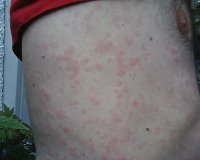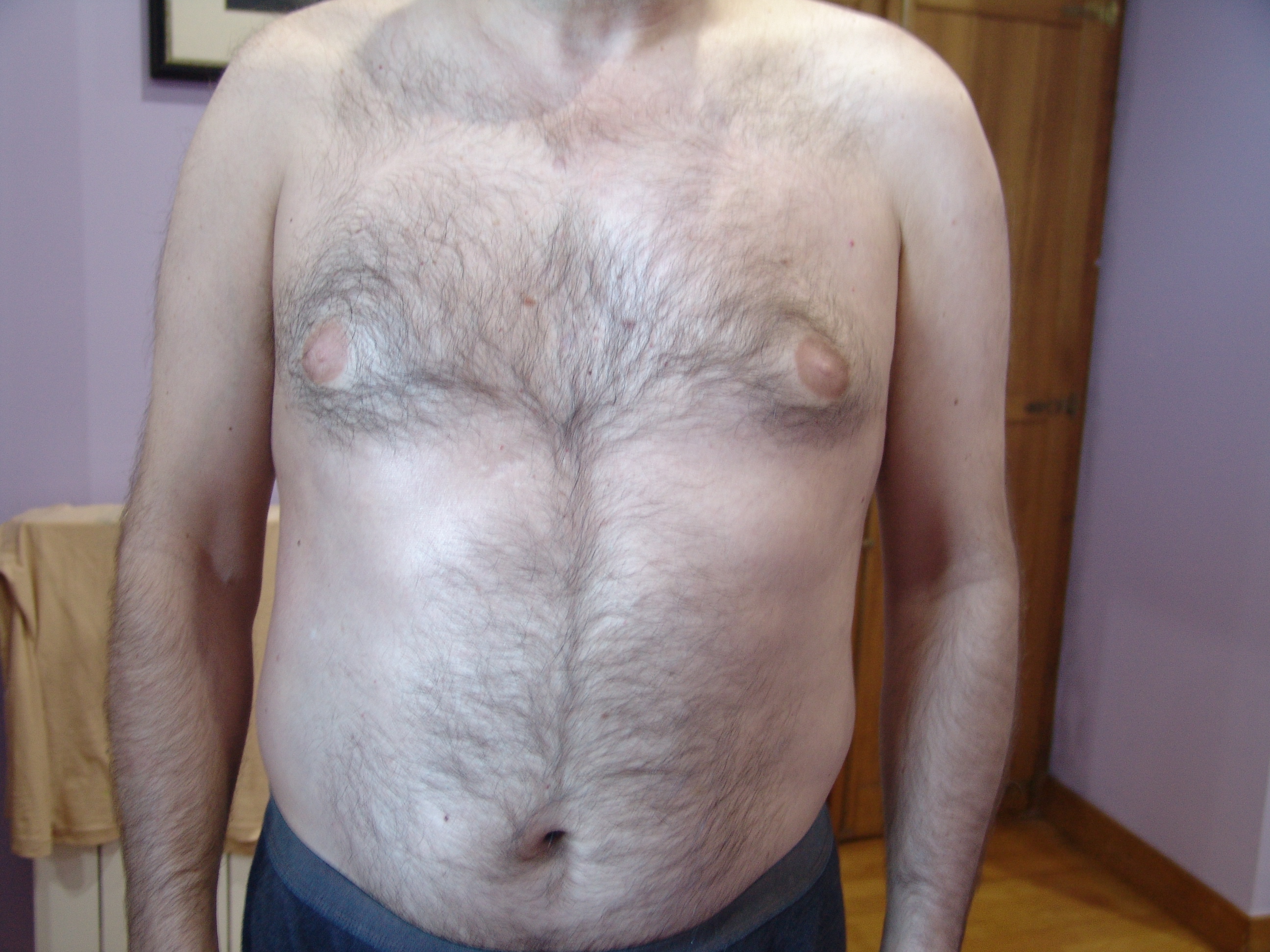INTRODUCTION
Schnitzler syndrome (SS) is a rare systemic disease with many common features of the inherited diseases group referred to as - auto-inflammatory syndromes1 It is characterized by chronic urticarial rash, monoclonal gammopathy (most IgM/kappa) and signs and symptoms of systemic inflammation, intermittent fever, bone pain and arthralgia. Rare cases of monoclonal IgG/κappa have also been reported.2 There is a slight male predominance and the mean age of disease onset is about 50-55 years.1
According to the Lipsker criteria, the syndrome is defined by the existence of urticarial rash, monoclonal IgM component and at least two other symptoms or signs (fever, arthralgia or arthritis, bone pain, palpable lymph nodes, liver or spleen enlargement, elevated sedimentation rate, leucocytosis and abnormal findings on bone morphologic investigation).3
SS pathophysiology is not entirely known but seems to have an auto-inflammatory origin.4 Nowadays, research focuses on the role of pro-inflammatory cytokines, such as Interleukin-1 (IL-1), a pro-inflammatory cytokine mainly released by cells of the innate immune system. IL-1 has been found to induce neutrophilia, anorexia, anaemia, fever, skin rash and serum markers of raised systemic inflammation.5 Also, the remarkable responses observed to Anakinra supports the theory that IL1 has an important role in the pathogenesis6, so that a non-response practically excludes the diagnosis. Within the last couple of years, there have been case reports of successful treatment with other IL-1 blockers7, and nowadays patients can be enrolled in clinical trials. Monoclonal gammopathy (MG), parallel to the urticarial rash, is a disease hallmark, but M-protein only became detectable several years after the onset of symptoms, which probably justifies the existence of some reports of SS cases without MG. Nowadays different lines of evidence support that MG arises in the sequence of chronic systemic inflammation.5
CASE REPORT
We report the case of a 47 year-old male with no relevant medical history. Since 2010 he developed cutaneous lesions, with 1-2mm, located in the trunk and limbs, erythematous, flat and slightly pruritic. Dermographism was not noticed (Fig. 1 and Fig. 2). He also complained of recurrent bone pain along the lower limbs and occasionally asymptomatic self-limited fever. Laboratory and imaging finding were inconclusive for several years. Meanwhile, a skin biopsy was done revealing the existence of “polymorphous inflammatory infiltrate”. Since then he had been treated with corticoids and anti-histamine drugs, due to the assumption of chronic urticaria, reporting only a slight and temporary improvement on symptoms.
When we first observed him in 2014, he had cutaneous erythematous spots, hepatomegaly and palpable axillary and inguinal lymphadenopathy. The initial study revealed anaemia, leucocytosis, elevated sedimentation rate and immunoelectroforesis shown a discrete monoclonal peak (IgG/Kappa). A computed tomography scan was performed, which showed a 1.8cm axillary and a 1.5cm pelvic lymphadenopathies and a slight homogeneous hepatomegaly. The inguinal ganglion was excised (as it was the most easily accessible), whose histology was inconclusive. Given the hypothesis of a lymphoproliferative disease, a myelogram and bone morrow biopsy were also performed, showing the presence of all cells lines with normal density, location and maturation, with plasmocytic cells responsible for less than 5% of the cellular population. Fluorescent in situ hybridization (FISH) showed 7% of cells positive for del (17) (p13.1) and 16% positive for atypical pattern t (4;14).
After exclusion of others diseases, Schnitzler Syndrome was considered to be the most probable diagnosis. In this context, treatment with Anakinra was proposed and started on March 2015, at a standard dose of 100 mg daily.8,9
The day after the first subcutaneous injection, rash fever and pain subsided (Fig. 3). Analytically, he had normalization of the blood count, sedimentation rate and C-reactive protein. We confirmed that he remained asymptomatic for a period of 60 hours (after which symptoms reappeared), so at this time Anakinra at alternate days was prescribed (this new scheme was stablishing for cost reasons).
In late October 2015, treatment was suspended. Despite being without therapy he remained pain free until April 2016, after which he experienced the reappearance of symptoms (skin spots, fever and pain). Anakinra was then reintroduced in July 2016, by another hospital, and all symptoms and signs disappeared again (Table 1).
The patient was recently observed at an appointment, three years after starting Anakinra. He referred that nowadays he can be asymptomatic for a period of up to 48hours. Fever and rash are de first symptoms to reaper but he can stay free from bone pain for up to a month. He also mentioned that in the past he had experienced some photosensitivity that resolved with the ongoing treatment.
DISCUSSION
Since first described in 1972, the definition of SS has evolved. In 2001 Lipsker at al, suggested diagnostic criteria that included urticarial rash, monoclonal IgM component and at least two other symptoms or signs (fever, arthralgia or arthritis, bone pain, palpable lymph nodes, liver or spleen enlargement, elevated sedimentation rate, leucocytosis and abnormal findings on bone morphologic investigation).3 Although most cases of SS have a monoclonal IgM k type gammopathy, over the years there have been reports of a variant type with IgG proteinemia (like our patient case). The exact role of monoclonal IgM or IgG in the pathogenesis of SS is not clear, but it did not seem to have an impact on clinical manifestations.2
Given the increase number of case reports of SS IgG variant, in 2012, an expert conference elaborated other diagnostic criteria, described as the “Strasbourg criteria”. This included two obligate criteria (chronic urticarial rash and monoclonal IgM or IgG) plus one or two minor criteria to fulfil a definitive or a probable diagnosis. Our patient meets the definitive diagnosis criteria. Nowadays, it is known that Lipsker and Strasbourg’s criteria are reliable to diagnose SS, showing a sensitivity and specificity superior to 90%.3
Schnitzler syndrome is likely to be under diagnosed as doctors are not commonly aware of this condition and there are no specific diagnostic tests. 10, 11 In our case report, our patient had symptoms for four years and at the time he came to our office, he had already been evaluated by a series of specialties and had a series of diagnosis and treatments.
Without treatment SS is a disabling disease and, to date, no spontaneous complete remissions have been reported.4 Anakinra has proved to be effective in the treatment of SS, with almost complete symptom resolution within 24 hours. Literature shows that when IL-1 inhibition is discontinued, symptoms will rapidly return. This implies that the disease process continues upstream of IL-1.10
When our patient started treatment with Anakinra at a standard dose of 100mg once aday, he had a remarkable response within 24-48 hours. However, for cost and hospital delivery reasons, a dose reduction was attempted and we found that our patient had a successful disease control for a period of 60 hours. In this context it was possible to establish a successful treatment regimen on alternate days for the next few months. When therapy was interrupted (due to lack of hospital supply of Anakinra), he maintained pain remission for a period of six months, after which he experienced a disease flare-up (both at a clinical and laboratory level). It was interesting to notice that the resumption of Anakinra treatment was associated with new disease remission. This aspect has supported, in one hand, the SS diagnosis, and in the other, the apparent absence of drug resistance. Furthermore, Anakinra at alternated days seemed to be an effective therapeutic scheme.
CONCLUSION
Although a rare disease, SS is likely to be under diagnosed mainly due to lack of knowledge over its existence. Since diagnosis criteria are very well documented and relatively straightforward to identify, more awareness of this disease may help to improve diagnosis. This is of major importance since in the absence of treatment SS is incapacitating disease.
Currently, Anakinra is an effective treatment to control SS at a standard dose of 100mg daily. However, in some cases, this treatment regimen may be altered without compromising patients´ quality of life. To our best knowledge, this case report is the first to describe a successful therapeutic scheme of 100mg on alternate days, however more studies will be necessary to validate it.
Quadro I
Table 1: Blood panel results before, during and after stop anakinra
| | | | | | |
| | | | | | |
| | August 2014 | March 2015 | May 2015 | October 2015 | October 2016 |
| Haemoglobin (g/dL) | 10,8 | 12,7 | 14,3 | 12,3 | 14,8 |
| Leukocytes (103/uL) | 13,1 | 17,5 | 5,4 | 15,6 | 6,7 |
| Platelets (103/uL) | 346 | 273 | 166 | 315 | 173 |
| Sedimentation rate (mm/h) | 96 | 63 | 15 | 92 | 13 |
| C-reactive protein (mg/L) | | 58 | <2,9 | 109 | 22 |
Figura I

Skin lesions on the forearm
Figura II

Skin lesions on the trunk
Figura III

Skin appearance after 48 hours of treatment
BIBLIOGRAFIA
1 Gouveia AI, Micaelo M, Pierdomenico F, Freitas JP. Schnitzler Syndrome: A Dramatic Response to Anakinra. Dermatol Ther (Heidelb). 2016 Jun; 6(2): 299–302.
2 Akimoto R, Yoshida M, Matsuda R, Miyasaka K, Itoh M. Schnitzler’s Syndrome with IgG κ Gammopathy. The Journal of Dermatology Vol. 29: 735–738, 2002
3 Gusdorf L, Asli B, Barbarot S, Néel A, Masseau A, Puéchal X. Schnitzler syndrome: validation and applicability of diagnostic criteria in real-life patients. Allergy. 2017 Feb;72(2):177-182. doi: 10.1111/all.13035. Epub 2016 Sep 12.
4 De Koning HD, Bodar EJ, Simon A, Van der Hilst JCH, Netea MG, van der Meer JWM. Beneficial response to Anakinra and thalidomide in Schnitzler´s syndrome. Ann Rheum Dis. 2006 Apr; 65(4): 542–544.
5 De Koning HD. Schnitzler’s syndrome: lessons from 281 cases. Clin Transl Allergy. 2014; 4: 41.
6 Billey T, Beldjerd M, Popa L, Lassoued S. Schnitzler syndrome: a dramatic improvement with Anakinra. Presse Med. 2010 Dec;39(12):1338-9
7 Robbie Pesek R, Fox R. Successful Treatment of Schnitzler Syndrome With Canakinumab. Cutis. 2014 September;94(3):E11-E12
8 Cascavilla N, Bisceglia M, D´Arena G. Successful treatment of Schnitzler´s syndrome with Anakinra after failure of rituximab trial. Int J Immunopathol Pharmacol. 2010 Apr-Jun;23(2):633-6.
9 Szturz P, Sedivá A, Zurek M, Adam Z, Stork J, Cermáková Z, et al. Anakinra treatment in Schnitzler syndrome - results of the first retrospective multicenter study in six patients from the Czech Republic. Klin Onkol. 2014;27(2):111-26.
10 Devlin LA, Wright G, Edgar JD. A rare cause of a common symptom, Anakinra is effective in the urticaria of Schnitzler Syndrome: a case report. Cases Journal 2008, 1:348
11 Jain T, Offord CP, Kyle RA, Dingli D. Schnitzler syndrome: an under-diagnosed clinical entity. Haematologica. 2013 Oct;98(10):1581-5




